10 Exercises You Should Be Doing Every Single Day
Incorporating daily exercise into your routine is essential for maintaining overall health and wellness. Here are ten exercises you should consider doing every day to stay fit, improve mobility, and boost your mood.
1. Walking
Walking is a simple yet effective way to get your body moving. Aim for at least 30 minutes of brisk walking daily to improve cardiovascular health, strengthen muscles, and enhance mental well-being.
2. Squats
Squats are excellent for building lower body strength. They target the quads, hamstrings, and glutes. Perform 3 sets of 15-20 squats daily to improve leg strength and stability.
3. Push-Ups
Push-ups are a fantastic upper body exercise that works the chest, shoulders, triceps, and core. Start with 3 sets of 10-15 push-ups, adjusting the number based on your fitness level.
4. Planks
Planks are great for core strength and stability. Hold a plank position for 30-60 seconds to increase the duration as you get stronger. Perform 3 sets daily.
5. Lunges
Lunges help improve balance and strengthen the legs and glutes. Perform 3 sets of 10-15 lunges on each leg daily to enhance lower body strength and coordination.
6. Bicycle Crunches
Bicycle crunches are effective for targeting the abdominal muscles. Perform 3 sets of 20-30 repetitions to work on your core strength and definition.
7. Jumping Jacks
Jumping jacks are a great cardiovascular exercise that also helps improve coordination. Aim for 3 sets of 30-50 jumping jacks to increase your heart rate and burn calories.
8. Glute Bridges
Glute bridges are excellent for strengthening the glutes and lower back. Perform 3 sets of 15-20 repetitions to improve hip stability and lower body strength.
9. Arm Circles
Arm circles are a simple yet effective way to warm up the shoulders and improve mobility. Perform 3 sets of 15-20 circles in each direction to keep your shoulders flexible and strong.
10. Stretching
Incorporate a full-body stretching routine to improve flexibility and prevent injuries. Spend at least 10-15 minutes stretching all major muscle groups daily.
Conclusion
Incorporating these ten exercises into your daily routine can enhance your overall fitness, improve mobility, and boost your mood. Consistency is vital, so make these exercises a regular part of your day to see the best results.

Daily Walking Routine
Incorporating walking into your daily routine is a great way to improve your overall health and well-being. Here’s a simple plan to get you started:
Morning: Warm-Up and Short Walk
- 5 minutes: Start with a gentle warm-up. Stretch your legs, arms, and back to prepare your body.
- 10-15 minutes: Go for a brisk walk around your neighborhood or a nearby park. This helps wake your body and mind, setting a positive tone for the day.
Midday: Lunchtime Walk
- 5 minutes: Do a quick stretch to loosen up.
- 20-30 minutes: Take a walk during your lunch break. This can help boost your energy levels and improve digestion.
Evening: Longer Walk and Cool Down
- 5 minutes: Warm up with some light stretching.
- 30-45 minutes: Go for a longer walk. You can vary your pace, incorporating brisk and slower walking intervals to keep things interesting.
- 5 minutes: Cool down with gentle stretching to relax your muscles and prevent stiffness.
Tips for Success
- Stay Hydrated: Drink water before, during, and after your walks.
- Wear Comfortable Shoes: Choose shoes with good arch support and cushioning.
- Track Your Progress: Use a pedometer or a fitness app to monitor your steps and distance.
- Mix It Up: Change your walking routes to keep things exciting and explore new areas.
- Stay Consistent: Aim to walk every day, even if it’s just for a short duration. Consistency is critical to reaping the benefits.

3-Set Body Squat Routine
Body squats are fantastic for building lower body strength and improving overall fitness. Here’s a simple 3-set routine you can follow:
Warm-Up
To prevent injury, warm up your muscles before starting your squats. Spend 5-10 minutes doing light cardio (like jogging in place or jumping jacks) and dynamic stretches (like leg swings and hip circles).
Routine
- Set 1: Basic Body Squats
- Repetitions: 15-20
- Instructions: Stand with your feet shoulder-width apart. Lower your body by bending your knees and pushing your hips back like sitting in a chair. Keep your chest up and your knees over your toes. Return to the starting position by pushing through your heels.
- Set 2: Pulse Squats
- Repetitions: 15-20
- Instructions: Perform a basic squat, but instead of standing up completely, pulse up and down in the lower part of the squat position for the desired number of repetitions. This increases the intensity and targets the muscles more effectively.
- Set 3: Jump Squats
- Repetitions: 10-15
- Instructions: Perform a basic squat, but jump explosively into the air as you rise. Land softly and immediately go into the next squat. This adds a cardio element and helps build explosive strength.
Cool Down
After completing your sets, cool down with some light stretching. Focus on your legs, hips, and lower back to help reduce muscle soreness and improve flexibility.
Tips for Success
- Maintain Proper Form: Keep your back straight, chest up, and knees aligned with your toes.
- Breathe: Inhale as you lower your body and exhale as you push up.
- Progress Gradually: If you’re new to squats, start with fewer repetitions and gradually increase as you get stronger.
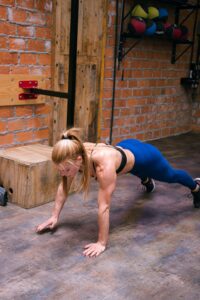
3-Set Push-Up Routine
Push-ups are a versatile exercise that targets the chest, shoulders, triceps, and core. Here’s a simple 3-set routine to help you build strength and endurance:
Warm-Up
Before starting your push-ups, warm up your muscles to prevent injury. Spend 5-10 minutes doing light cardio (like jogging in place or jumping jacks) and dynamic stretches (like arm circles and shoulder rolls).
Routine
- Set 1: Standard Push-Ups
- Repetitions: 10-15
- Instructions: Start in a plank position with your hands shoulder-width apart. Lower your body until your chest nearly touches the floor, then push back up to the starting position. Keep your body in a straight line throughout the movement.
- Set 2: Wide Push-Ups
- Repetitions: 10-15
- Instructions: Perform push-ups with your hands placed wider than shoulder-width apart. This variation more intensely targets the chest muscles. Lower your body and push back up, maintaining proper form.
- Set 3: Diamond Push-Ups
- Repetitions: 8-12
- Instructions: Place your hands together under your chest, forming a diamond shape with your thumbs and index fingers. Lower your body and push back up. This variation emphasizes the triceps.
Cool Down
After completing your sets, cool down with some light stretching. Focus on your chest, shoulders, and triceps to help reduce muscle soreness and improve flexibility.
Tips for Success
- Maintain Proper Form: Keep your back straight, core engaged, and elbows close to your body.
- Breathe: Inhale as you lower your body and exhale as you push up.
- Progress Gradually: If you’re new to push-ups, start with fewer repetitions and gradually increase as you get stronger.
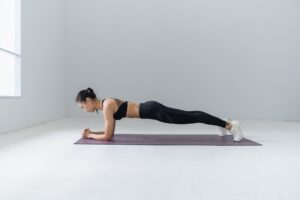
3-Set Plank Routine
Planks are an excellent exercise for building core strength and stability. Here’s a simple 3-set routine to help you get started:
Warm-Up
Before starting your planks, warm up your muscles to prevent injury. Spend 5-10 minutes doing light cardio (like jogging in place or jumping jacks) and dynamic stretches (like arm circles and torso twists).
Routine
- Set 1: Standard Plank
- Duration: 30-60 seconds
- Instructions: Start in a plank position with your forearms on the ground and elbows directly under your shoulders. Keep your body in a straight line from head to heels. Engage your core and hold the position for the desired duration.
- Set 2: Side Plank
- Duration: 20-30 seconds per side
- Instructions: Lie on your side with your legs stacked. Prop yourself up on your forearm, keeping your elbow under your shoulder. Lift your hips to form a straight line from head to feet. Hold the position, then switch sides.
- Set 3: Plank with Leg Lift
- Duration: 30-60 seconds
- Instructions: Start in a standard plank position. Lift one leg off the ground and hold for a few seconds, then switch legs. Continue alternating legs for the duration of the set.
Cool Down
After completing your sets, cool down with some light stretching. Focus on your core, lower back, and shoulders to help reduce muscle soreness and improve flexibility.
Tips for Success
- Maintain Proper Form: Keep your body straight and avoid letting your hips sag or rise.
- Breathe: Inhale and exhale steadily throughout the exercise.
- Progress Gradually: If you’re new to planks, start with shorter durations and gradually increase as you get stronger.
3-Set Body Lunge Routine
Lunges are excellent for building lower body strength, improving balance, and enhancing overall fitness. Here’s a simple 3-set routine you can follow:
Warm-Up
Before starting your lunges, warm up your muscles to prevent injury. Spend 5-10 minutes doing light cardio (like jogging in place or jumping jacks) and dynamic stretches (like leg swings and hip circles).
Routine
- Set 1: Forward Lunges
- Repetitions: 10-15 per leg
- Instructions: Stand with your feet hip-width apart. Step forward with one leg and lower your hips until both knees are bent at about a 90-degree angle. Push back to the starting position and repeat on the other leg.
- Set 2: Reverse Lunges
- Repetitions: 10-15 per leg
- Instructions: Stand with your feet hip-width apart. Step backward with one leg and lower your hips until both knees are bent at about a 90-degree angle. Push back to the starting position and repeat on the other leg.
- Set 3: Side Lunges
- Repetitions: 10-15 per leg
- Instructions: Stand with your feet wider than shoulder-width apart. Shift your weight to one leg and bend that knee while keeping the other leg straight. Push back to the starting position and repeat on the other side.
Cool Down
After completing your sets, cool down with some light stretching. Focus on your legs, hips, and lower back to help reduce muscle soreness and improve flexibility.
Tips for Success
- Maintain Proper Form: Keep your back straight, chest up, and knees aligned with your toes.
- Breathe: Inhale as you step forward or backward, and exhale as you push back to the starting position.
- Progress Gradually: If you’re new to lunges, start with fewer repetitions and gradually increase as you get stronger.
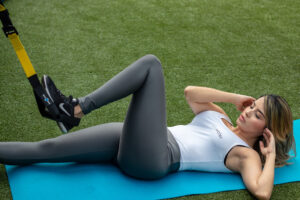
3-Set Bicycle Crunch Routine
Bicycle crunches are a fantastic exercise for targeting your abdominal muscles, including the obliques. Here’s a simple 3-set routine to help you strengthen your core:
Warm-Up
Before starting your bicycle crunches, warm up your muscles to prevent injury. Spend 5-10 minutes doing light cardio (like jogging in place or jumping jacks) and dynamic stretches (like torso twists and leg swings).
Routine
- Set 1: Standard Bicycle Crunches
- Repetitions: 15-20
- Instructions: Lie flat on your back with your hands behind your head. Lift your legs to a tabletop position. Bring your right elbow towards your left knee while extending your right leg. Alternate sides in a pedaling motion, engaging your core throughout.
- Set 2: Slow Bicycle Crunches
- Repetitions: 10-15
- Instructions: Perform the standard bicycle crunches but at a slower pace. Focus on contracting your abdominal muscles and maintaining proper form. This increases the intensity and ensures better muscle engagement.
- Set 3: Bicycle Crunches with Hold
- Repetitions: 10-15 per side
- Instructions: Perform a standard bicycle crunch, but hold the twist for 2-3 seconds before switching sides. This adds an isometric component, increasing the challenge and effectiveness.
Cool Down
After completing your sets, cool down with some light stretching. Focus on your core, lower back, and hip flexors to help reduce muscle soreness and improve flexibility.
Tips for Success
- Maintain Proper Form: Keep your lower back pressed into the mat and avoid pulling on your neck.
- Breathe: Inhale as you switch sides and exhale as you crunch.
- Progress Gradually: If you’re new to bicycle crunches, start with fewer repetitions and gradually increase as you get stronger.
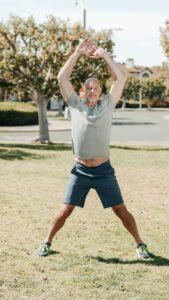
3-Set Jumping Jack Routine
Jumping jacks are a great cardiovascular exercise that also helps improve coordination and overall fitness. Here’s a simple 3-set routine to get you started:
Warm-Up
Before starting your jumping jacks, warm up your muscles to prevent injury. Spend 5-10 minutes doing light cardio (like jogging in place or marching) and dynamic stretches (like arm circles and leg swings).
Routine
- Set 1: Standard Jumping Jacks
- Repetitions: 30-50
- Instructions: Stand with your feet together and arms at your sides. Jump up, spreading your legs shoulder-width apart while raising your arms overhead. Jump again to return to the starting position. Repeat for the desired number of repetitions.
- Set 2: Squat Jacks
- Repetitions: 20-30
- Instructions: Start in a half-squat position with your feet together and arms at your sides. Jump up, spreading your legs wider than shoulder-width apart while raising your arms overhead. Return to the squat position and repeat. This variation intensifies your legs.
- Set 3: Cross Jacks
- Repetitions: 20-30
- Instructions: Start with your feet together and arms at your sides. Jump up, spreading your legs and crossing one foot in front of the other while crossing your arms in front of your chest. Jump again to return to the starting position, then alternate the crossing foot and arm. This variation helps improve coordination.
Cool Down
After completing your sets, cool down with some light stretching. Focus on your legs, arms, and shoulders to help reduce muscle soreness and improve flexibility.
Tips for Success
- Maintain Proper Form: Keep your back straight, core engaged, and land softly to reduce impact on your joints.
- Breathe: Inhale as you jump out and exhale as you jump back in.
- Progress Gradually: If you’re new to jumping jacks, start with fewer repetitions and gradually increase as you get stronger.

3-Set Glute Bridge Routine
Glute bridges are excellent for strengthening the glutes, lower back, and core. Here’s a simple 3-set routine to help you get started:
Warm-Up
Before starting your glute bridges, warm up your muscles to prevent injury. Spend 5-10 minutes doing light cardio (like jogging in place or jumping jacks) and dynamic stretches (like leg swings and hip circles).
Routine
- Set 1: Standard Glute Bridges
- Repetitions: 15-20
- Instructions: Lie on your back with your knees bent and feet flat on the ground, hip-width apart. Place your arms at your sides. Lift your hips towards the ceiling by squeezing your glutes and pushing through your heels. Hold for a second at the top, then lower back down.
- Set 2: Single-Leg Glute Bridges
- Repetitions: 10-12 per leg
- Instructions: Lie on your back with your knees bent and feet flat on the ground. Extend one leg straight out. Lift your hips towards the ceiling using the same motion as the standard glute bridge but with one leg extended. Switch legs after completing the repetitions.
- Set 3: Glute Bridge with Hold
- Repetitions: 15-20
- Instructions: Perform a standard glute bridge, but hold the top position for 3-5 seconds before lowering back down. This increases the intensity and engages the muscles more effectively.
Cool Down
After completing your sets, cool down with some light stretching. Focus on your glutes, lower back, and hip flexors to help reduce muscle soreness and improve flexibility.
Tips for Success
- Maintain Proper Form: Keep your core engaged and avoid arching your lower back.
- Breathe: Inhale as you lower your hips and exhale as you lift.
- Progress Gradually: Start with fewer repetitions if you’re new to glute bridges and gradually increase as you get stronger.
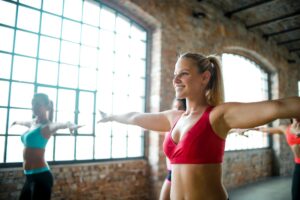
3-Set Arm Circle Routine
Arm circles are a great dynamic stretching exercise that helps improve shoulder mobility and warm up the upper body. Here’s a simple 3-set routine to get you started:
Warm-Up
Before starting your arm circles, warm up your muscles to prevent injury. Spend 5-10 minutes doing light cardio (like jogging in place or marching) and dynamic stretches (like shoulder rolls and arm swings).
Routine
- Set 1: Forward Arm Circles
- Repetitions: 15-20 circles in each direction
- Instructions: Stand with your feet shoulder-width apart and arms extended to the sides at shoulder height. Make small forward circles with your arms, gradually increasing the size of the circles. After completing the forward circles, reverse the direction and perform backward circles.
- Set 2: Large Arm Circles
- Repetitions: 10-15 circles in each direction
- Instructions: Perform the same movement as in Set 1, but make larger circles with your arms. This increases the range of motion and engages the shoulder muscles more intensely. Complete the forward circles first, then switch to backward circles.
- Set 3: Weighted Arm Circles
- Repetitions: 10-15 circles in each direction
- Instructions: Hold a lightweight (1-2 pounds) in each hand. Perform arm circles as in Set 1, starting with small circles and gradually increasing the size. Complete the forward circles first, then switch to backward circles. The added weight increases the intensity and helps build strength.
Cool Down
After completing your sets, cool down with some light stretching. Focus on your shoulders, arms, and upper back to help reduce muscle soreness and improve flexibility.
Tips for Success
- Maintain Proper Form: Keep your back straight, core engaged, and arms extended without locking your elbows.
- Breathe: Inhale and exhale steadily throughout the exercise.
- Progress Gradually: If you’re new to arm circles, start with smaller circles and lighter weights and gradually increase as you get stronger.
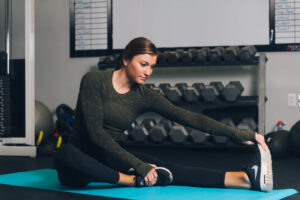
Summary of Full Body Stretches
Full-body stretches improve flexibility, promote recovery, and prevent injuries. Here’s a quick guide to performing a comprehensive stretching routine:
Warm-Up
Before stretching, warm up your muscles with 5-10 minutes of light cardio, such as jogging in place or jumping jacks.
Stretching Routine
- Neck Stretch
- Instructions: Gently tilt your head to one side, bringing your ear towards your shoulder. Hold for 15-30 seconds and switch sides.
- Shoulder Stretch
- Instructions: Extend one arm across your body and use the opposite hand to pull it closer gently. Hold for 15-30 seconds and switch arms.
- Triceps Stretch
- Instructions: Raise one arm overhead and bend the elbow, reaching down your back. Use the opposite hand to push the elbow gently. Hold for 15-30 seconds and switch arms.
- Chest Stretch
- Instructions: Stand with your feet shoulder-width apart. Clasp your hands behind your back and gently lift your arms. Hold for 15-30 seconds.
- Upper Back Stretch
- Instructions: Clasp your hands in front of you and round your upper back, pushing your hands forward. Hold for 15-30 seconds.
- Side Stretch
- Instructions: Stand with your feet shoulder-width apart. Raise one arm overhead and lean to the opposite side. Hold for 15-30 seconds and switch sides.
- Hamstring Stretch
- Instructions: Sit on the ground with one leg extended and the other bent. Reach towards the toes of the extended leg. Hold for 15-30 seconds and switch legs.
- Quadriceps Stretch
- Instructions: Stand on one leg and pull the opposite foot towards your glutes. Hold for 15-30 seconds and switch legs.
- Hip Flexor Stretch
- Instructions: Kneel on one knee with the other foot in front. Gently push your hips forward. Hold for 15-30 seconds, then switch sides.
- Calf Stretch
- Instructions: Stand facing a wall with one foot forward and the other back. Press the back heel into the ground. Hold for 15-30 seconds and switch legs.
Cool Down
After stretching, cool down with some deep breathing exercises to help relax your muscles and mind.
Tips for Effective Stretching
- Hold Each Stretch: Aim to hold each stretch for 15-30 seconds without bouncing.
- Breathe Deeply: Inhale deeply and exhale slowly to help your muscles relax.
- Avoid Pain: Stretch to the point of mild tension, not pain.
- Stay Consistent: Stretch daily for the best results.
Incorporating these ten exercises into your daily routine can enhance your overall fitness, improve mobility, and boost your mood. Consistency is key, so make these exercises a regular part of your day to see the best results.
Before beginning any fitness program, you must check with your doctor to reduce and avoid injury. By performing any fitness exercises, you are performing them at your own risk. endlesssummerfitness.com will not be responsible or liable for any injury or harm you sustain due to our fitness program, online fitness videos, or information shared on our website. This includes emails, videos, and text.
Bing Copilot, AI software, GPT-4, partially generated this article. Endless Summer Fitness will continue experimenting with similar software; however, our author will create most articles and fitness programs.





